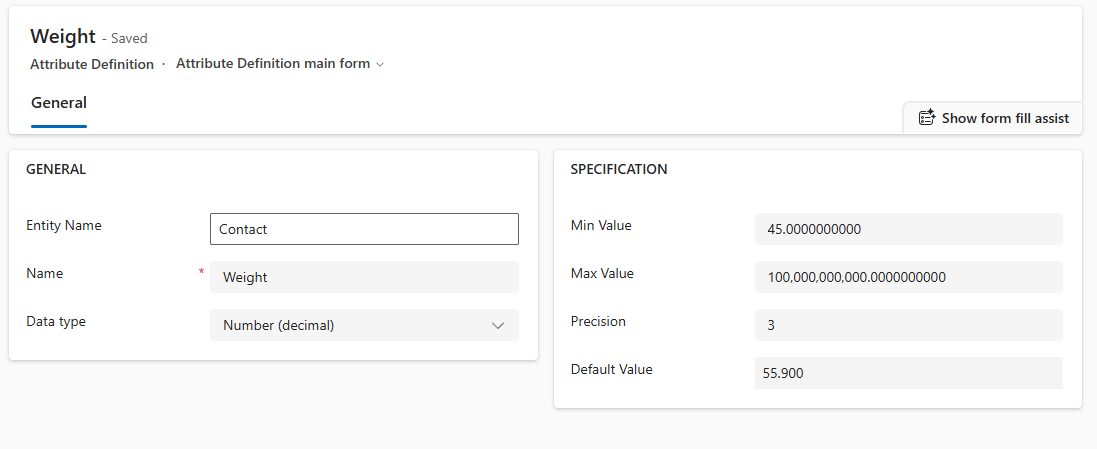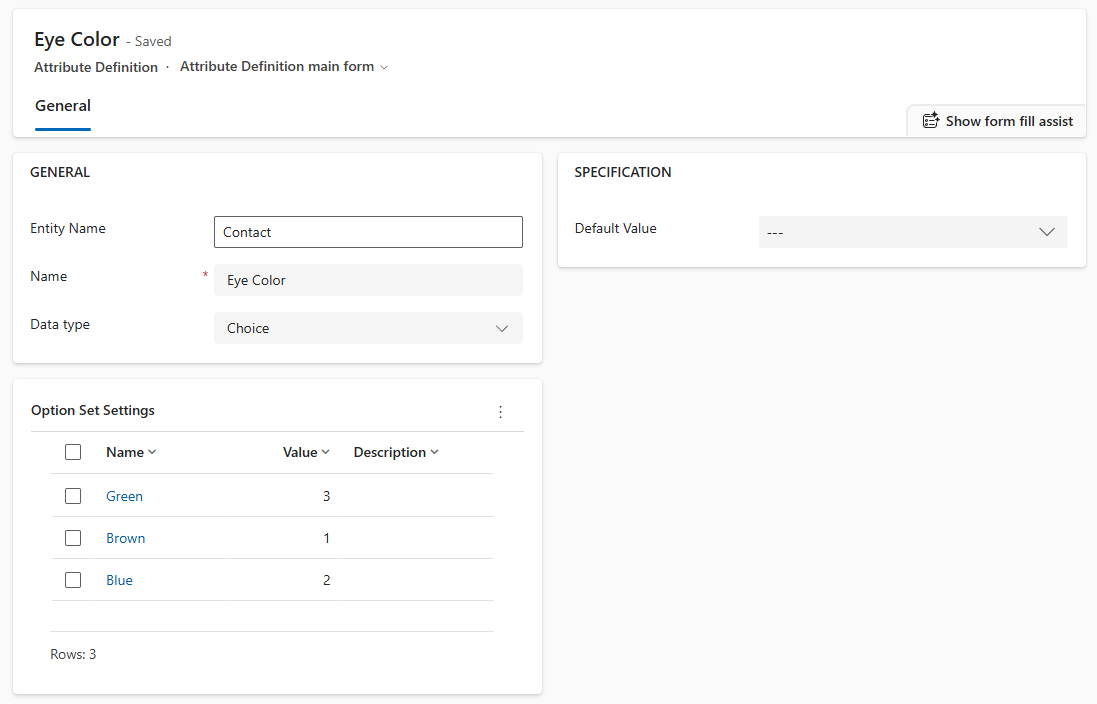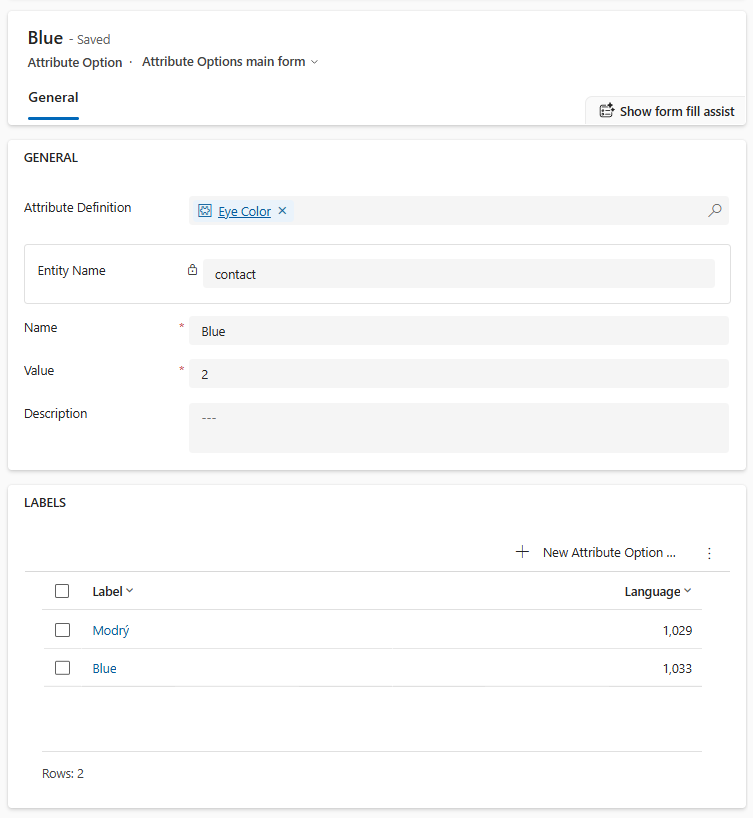Dynamic Attributes
# Introduction
The Dynamic Attribute feature enables a flexible way to define and manage custom attributes across any entity in the system. Instead of modifying existing entity schemas, dynamic attributes are defined and stored separately, allowing extensibility without schema changes.
# Basic concepts
- Attribute Definition - configuration for dynamic attribute
- Attribute definition Data Types - supported dynamic attribute data types
- Attribute Option - single option in the optionset related to Attribute Definition of type Choice
- Attribute Option Label - label for one option (different labels for different languages)
- PCFs this feature is dependent on
- Setup Guide
# Entities
# Attribute Definition (talxis_attributedefinition)
Represents the attribute configuration. Each Attribute Definition defines how the corresponding attribute should behave (data type, metadata, default value):
| Display Name | Logical Name | Description |
|---|---|---|
| Name | talxis_name | Display name of the attribute definition. |
| Data Type | talxis_datatypetypecode | Data type for Dynamic Attribute. |
| Entity Name | talxis_entityname | Defines the entity that attribute describes. |
| Min Value | talxis_int_min | Optional metadata for int (min value). |
| Max Value | talxis_int_max | Optional metadata for int (max value). |
| Min Value | talxis_decimal_min | Optional metadata for decimal (min value). |
| Max Value | talxis_decimal_max | Optional metadata for decimal (max value). |
| Precision | talxis_decimal_precision | Optional metadata for decimal (precision). |
| Maximum character count | talxis_text_maxcharcount | Optional metadata for text (max length). |
| Description | talxis_description | Attribute description. |
| Default Value | talxis_text_default | Default value for Text type. |
| Default Value | talxis_int_default | Default value for Integer type. |
| Default Value | talxis_decimal_default | Default value for Decimal type. |
| Default Value | talxis_choice_default | Default value for Choice type (Lookup on Attribute Option). |
| Default Value | talxis_bit_default | Default value for Boolean type. |
| Default Value | talxis_date_default | Default value for Date type. |
| Default Value | talxis_datetime_userlocal_default | Default value for DateTime User Local type. |
| Default Value | talxis_datetime_tzi_default | Default value for DateTime Time Zone independent type. |
| Default Value | talxis_defaultvalue_serialized | Serialized (JSON) Default value (Dynamic Attribute PCF binding). |
| Attribute Definition Lookup | talxis_attributedefinitionlookupid | Self referencing lookup for Dynamic Attribute PCF input binding. |
# Attribute Definition Lookup
Self referencing lookup that is automatically populated by
talxis_populateattributedefinitionlookupWorkflow ontalxis_attributedefintionrecord creation.
# Data Type optionset (talxis_datatypetypecode)
Defines Attribute type. Supported types:
| Label | Value |
|---|---|
| Text | 742070000 |
| Number (whole) | 742070001 |
| Number (decimal) | 742070002 |
| Choice | 742070003 |
| Boolean | 742070004 |
| Date | 742070005 |
| Date Time (User Local) | 742070006 |
| Date Time (Time zone independent) | 742070007 |
# Decimal type Attribute Defintion

# Attribute Option (talxis_attributeoption)
Options related for one attribute definition record of type Choice:
| Display Name | Logical Name | Description |
|---|---|---|
| Name | talxis_name | Display name of the attribute option. |
| Attribute Definition | talxis_attributedefinitionid | Attribute definition lookup. |
| Value | talxis_value | Integer value for option in the optionset. |
| Description | talxis_description | Attribute option description. |
# Choice type Attribute Defintion

# Attribute Option Label (talxis_attributeoptionlabel)
Every attribute option can have multiple labels depending on app languages:
| Display Name | Logical Name | Description |
|---|---|---|
| Name | talxis_name | Display name of the Label. |
| Attribute Option | talxis_attributeoptionid | Attribute option lookup. |
| Language | talxis_language | Integer value for language code. |
# Attribute Option Labels

# Attribute Value (talxis_attributevalue)
Stores the actual value input by the user for a specific attribute and specific record:
| Display Name | Logical Name | Description |
|---|---|---|
| Name | talxis_name | Display name of the attribute value. |
| Attribute Definition | talxis_attributedefinitionid | Lookup to attribute definition. |
| Regarding | talxis_regardingobjectid | Reference to the target entity (polymorphic lookup: Contact, Account, etc.). |
| Value | talxis_text_value | Corresponding value field for Text type. |
| Value | talxis_int_value | Corresponding value field for Integer type. |
| Value | talxis_decimal_value | Corresponding value field for Decimal type. |
| Value | talxis_choice_value | Corresponding value field for Choice type (Lookup on Attribute Option). |
| Value | talxis_bit_value | Corresponding value field for Boolean type. |
| Value | talxis_date_value | Corresponding value field for Date type. |
| Value | talxis_datetime_userlocal_value | Corresponding value field for DateTime User Local type. |
| Value | talxis_datetime_tzi_value | Corresponding value field for DateTime Time Zone independent type. |
| Value | talxis_serialized_value | Serialized (JSON) value (DynamicAttribute PCF bindingField). |
# Serialized value
Serialized value fields are text fields that are used to bind Dynamic Attribute PCF so user can easily edit specific attribute value by using propper Base Control based on the selected Data Type.
Serialized value format:
{
"raw": 150,
"error": true,
"errorMessage": "Number must be less than 100",
}
2
3
4
5
# Setup Guide
To enable this feature in your app for specific Entity you have to:
- Extend
talxis_regardingobjectidpolymorphic lookup with relationship to your desired entity. Don't forget to check if it already exists!
Example of existing contact -> talxis_attributedefinition relationship.
<EntityRelationship Name="talxis_contact_talxis_attributevalue_regardingobjectid">
<EntityRelationshipType>OneToMany</EntityRelationshipType>
<IsCustomizable>1</IsCustomizable>
<IntroducedVersion>1.0</IntroducedVersion>
<IsHierarchical>0</IsHierarchical>
<ReferencingEntityName>talxis_attributevalue</ReferencingEntityName>
<ReferencedEntityName>contact</ReferencedEntityName>
<CascadeAssign>NoCascade</CascadeAssign>
<CascadeDelete>RemoveLink</CascadeDelete>
<CascadeArchive>RemoveLink</CascadeArchive>
<CascadeReparent>NoCascade</CascadeReparent>
<CascadeShare>NoCascade</CascadeShare>
<CascadeUnshare>NoCascade</CascadeUnshare>
<CascadeRollupView>NoCascade</CascadeRollupView>
<IsValidForAdvancedFind>1</IsValidForAdvancedFind>
<ReferencingAttributeName>talxis_regardingobjectid</ReferencingAttributeName>
<RelationshipDescription>
<Descriptions>
<Description description="Regarding" languagecode="1033" />
<Description description="Regarding" languagecode="1029" />
</Descriptions>
</RelationshipDescription>
<EntityRelationshipRoles>
<EntityRelationshipRole>
<NavPaneDisplayOption>UseCollectionName</NavPaneDisplayOption>
<NavPaneArea>Details</NavPaneArea>
<NavPaneOrder>10000</NavPaneOrder>
<NavigationPropertyName>talxis_regardingobjectid_contact</NavigationPropertyName>
<RelationshipRoleType>1</RelationshipRoleType>
</EntityRelationshipRole>
<EntityRelationshipRole>
<NavigationPropertyName>talxis_contact_talxis_attributevalue_regardingobjectid</NavigationPropertyName>
<RelationshipRoleType>0</RelationshipRoleType>
</EntityRelationshipRole>
</EntityRelationshipRoles>
</EntityRelationship>
2
3
4
5
6
7
8
9
10
11
12
13
14
15
16
17
18
19
20
21
22
23
24
25
26
27
28
29
30
31
32
33
34
35
36
- Make sure PCFs for this feature are imported.
- Add
talxis_attributedefinition,talxis_attributeoptionandtalxis_attributeoptionlabelviews and forms from Environment\Bootstrap\Apps.Default (opens new window) in your App in desired SiteMap Areas. - Create
Dynamic Attribute Grid PCFText Attribute in desired Entity and bind Dynamic Attribute Grid PCF to it.
# Setup guide for M2M relationships in this feature
While in many cases a Dynamic Attribute is used to describe a property of a single entity (such as a Product or Contact), there are also scenarios where an attribute needs to describe a property of a relationship between two or more entities.
For example:
- A Contact might have different preferences or behaviors depending on the Product they are associated with
- A Professor (Contact) might have different Teaching Styles depending on the Subject they are teaching
In these situations, a Dynamic Attribute is not related to just one entity, but rather to a combination of entities. These are steps that are needed to support attributes that describe properties for more than one Entity:
- Create a custom intersecting entity (e.g., Contact - Product, Contact - Market - Subjet)
- Extend
talxis_regardingobjectidpolymorphic lookup intalxis_attributevalueentity with relationship to intersecting entity. - Create custom
talxis_attributevalueview for Dynamic Attribute Grid with relevant columns and interceptors. - Create custom Dialog that will be opened on creation of new Attribute value - This Dialog should handle
talxis_attributevaluecreation logic alongside with necessary intersecting entity record creations and lookups - Make sure PCFs for this feature are imported.
- Add
talxis_attributedefinition,talxis_attributeoptionandtalxis_attributeoptionlabelviews and forms from Environment\Bootstrap\Apps.Default (opens new window) in your App in desired SiteMap Areas. - Create
Dynamic Attribute Grid PCFText Attribute in desired Entity and bind Dynamic Attribute Grid PCF to it.

